Hayden
Grasshopper
|
|
|
|
Geographic range of Derotmema haydeni (Thomas) |
|
|
Distribution
and Habitat
Economic
Importance
Food
Habits
Migration
and Dispersal
Identification
Hatching
Nymphal
Development
Adults
and Reproduction
Population
Ecology
Daily
Activity
Selected
References
Click here for the printable version
Distribution and Habitat
The Hayden grasshopper has a wide geographic range in western North America. It inhabits the mixed-grass, shortgrass, desert, and bunchgrass prairies. In these divisions of vegetation it usually occupies disturbed land with a high percentage of barren area. It is frequently found in prairie dog towns, at the sides of county and ranch roads, in abandoned fields, and in vacant city lots.
Economic Importance
The Hayden grasshopper causes little damage to rangeland forage. Densities of this grasshopper are usually low, and it feeds mainly on forbs.
Food Habits
This grasshopper appears to prefer certain forbs. In laboratory preference tests, adults clearly preferred leaves of dandelion to leaves of blue grama, western wheatgrass, prostrate knotweed, and Russian thistle, but fed nearly as well on downy brome as dandelion. In Montana it has been observed to feed on common purslane. Crop contents of one nymphal and five adult specimens collected in the shortgrass prairie of the Pawnee Grassland (Colorado) consisted of 69 percent plains bahia, 10 percent scarlet globemallow, 7 percent needleleaf sedge, and 6 percent fringed sagebrush; three other forbs and three grasses made up the remaining items (8 percent).
Several direct observations of its feeding indicate that it feeds on dry plant litter and on recumbent green leaves from a horizontal position on the ground. In the laboratory it was observed feeding on the edge of a green dandelion leaf. Further observations are needed to find out how it attacks upright plants such as plains bahia and scarlet globemallow.
Dispersal and Migration
|
Figures 1-5. Appearance
of the five nymphal instars, their sizes, structures, and
color patterns. Notice progressive development of the wing
pads. BL=body length, FL=Hind Femur Length. AS=number of antennal
segments
|
|
|
|
Fig. 1,
First Instar: BL 3.8-4.7 mm FL 2.2-2.4 mm AS 13-14.
|
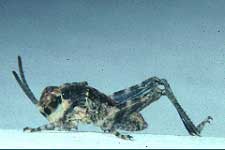 |
|
Fig. 2,
Second Instar: BL 5.0-6.7 mm FL 3.3-3.6 mm AS 16-17.
|
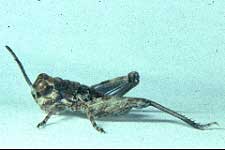 |
|
Fig. 3,
Third Instar: BL 6.3-8.2 mm FL 4.1-4.3 mm AS 18-20.
|
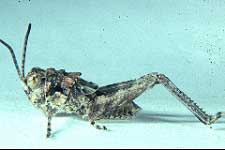 |
|
Fig. 4,
Fourth Instar: BL 8.1-12.7 mm FL 5.5-6.2 mm AS
21-22.
|
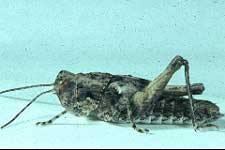 |
|
Fig. 5,
Fifth Instar: BL 12-18.5
mm FL 7.5-8.7 mm AS 23-26.
|
|
Figures 6-10. Appearance
of the adult male and female, rust spots on abdominal sterna
of nymph, wings of an adult female, and egg pod and exposed
eggs.
|
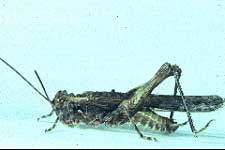 |
|
Fig. 6,
Adult Male: BL 15.5-17 mm FL 9-10.2 mm AS 24-26.
|
 |
|
Fig. 7,
Adult Female: BL 20-25 mm FL 10.7-12.6 mm AS 24-26.
|
|
|
|
Fig. 8,
Paired rust spots on abdominal sterna and metasternum of nymphal
instar IV.
|
 |
|
Fig. 9,
Spread wings of female.
|
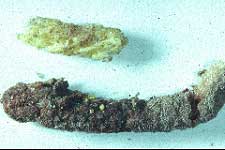 |
|
Fig. 10,
Egg pod and exposed eggs of another pod.
|
No observations of dispersal or migration by this grasshopper have been made. However, its possession of long wings that extend beyond the abdomen in both males and females suggests that it has the capacity to fly long distances.
Evasive flights of the species have been observed. Their distances range from 2 to 6 feet and their heights from 4 to 10 inches. The flights may be straight or the grasshopper may make a right angle turn midway in the flight. Flights begin from the ground and end on the ground. They may have a smooth trajectory or they may end abruptly by a quick turn of the flying insect. In the latter trajectory the grasshoppers appear to drop out of the air to the ground facing in various directions on landing.
Identification
The Hayden grasshopper is a medium-sized, bulbous-eyed, bandwinged species (Fig. 6 and 7). General body color is tan and brown. The tegmina are marked with many fuscous spots; the hindwings have a broad dark band that extends from front to hind margin and a red or yellow basal area ( Fig. 9). The disk of the pronotum has prominent ridges and nodules; the median carina is distinct and cut twice, once near the middle and once in front of the middle; the posterior margin of the disk is angulate.
The nymphs are identifiable by their shape, structures, and color patterns. First instar nymphs are distinctively marked by four shiny black nodules on the front of the head and two on the pronotum (Fig. 1). A flat black patch is located on the head behind each compound eye. Below these marks, a broad yellow or light tan band runs around the head and onto the lateral lobes of the pronotum. The band becomes less clear, and the nodules flatten and become less dark and shiny in instars II and III and disappear in instars IV and V.
Other distinguishing characteristics of the nymphs (Fig. 1-5) include the following:
- Head with protruding, bulbous compound eyes; fastigium steeply slanted; antennae filiform.
- Thorax raised in instars I to III, giving a humpbacked appearance to the early instars. Pronotum with distinct median carina, cut twice; disk rugose and nodulate, more so in older instars; posteroventral angle of lateral lobe rounded.
- Bottom of abdomen cream or tan with a pair of rust-colored spots on each segment ( Fig. 8), spots fainter and fewer in instar I, spots more numerous in instar V.
- General body color brown and tan.
Hatching
The Hayden grasshopper is considered a late-hatching species. The eggs hatch four to five weeks after those of the bigheaded grasshopper, Aulocara elliotti. In eastern Colorado and eastern Wyoming hatching occurs during June. No investigation of embryonic development of this species has been made.
Nymphal Development
The five nymphal instars require about 40 days to develop to the adult stage. Because of the extended hatching time, as many as three different instars may be found in the habitat during much of the nymphal period. In eastern Colorado and Wyoming adults begin to appear during the last few days of July.
Adults and Reproduction
The adults remain in the same habitat in which they developed as nymphs. They live active lives during August and September. Little is known about their reproductive biology. Observations have been made on courtship, which appears to vary slightly among populations studied in Colorado, Utah, and California. However, at all three locations courtship was rather short and simple and usually consisted of the male tipping his hind femora, stridulating one to three times, and then mounting the female.
No information is available on when females begin to oviposit, how many eggs they produce during their life, or where they oviposit. In the laboratory, females readily oviposit into a container of bare soil. They take approximately one hour to complete an oviposition. The pods are curved, about an inch long, and contain 16 to 17 pale yellow eggs 4.3 mm long (Fig. 10). There is one generation annually.
Population Ecology
No special study of the ecology of this grasshopper has been undertaken. From other studies we do know a few facts about their population ecology: the species has a wide geographic range in the West, densities are usually low, and dispersion of individuals is concentrated in the bare areas of mixedgrass and shortgrass prairies. In shrub-grass habitats with a preponderance of bare areas, individuals are scattered throughout the habitat. Densities of clumped adults are usually no more than one per square yard, but on occasion they may become higher. In the Marfa prairie of the Big Bend Region of Texas, Ernest R. Tinkham (1904-87), a well-known entomologist and naturalist, found this species "quite abundant" on bare adobe patches.
Daily Activity
The Hayden grasshopper is a ground-dwelling insect. At night nymphs and adults rest horizontally on the ground surface either under a canopy of plants, or exposed without any cover. Approximately one hour after sunrise both nymphs and adults begin to bask in the warming rays of the sun. They turn a side perpendicular to the rays and lower the hindleg of the exposed side to the ground. After basking for about two hours, adults begin normal activities of walking about on open ground, occasionally producing femur-tipping movements, feeding, and mating. These activities continue until ground temperatures in the afternoon become too hot (120°F and above). Then they seek the shade of vegetation and rest horizontally on the ground surface. After soil temperatures moderate they again become active. They may come out into the sun too soon and take a stilt posture in which they hold their bodies off the hot (101°F) ground surface. In the evening they bask again and finally take their night time positions sitting horizontally on the ground surface.
Selected References
Anderson, N. L. 1973. The vegetation of rangeland sites associated with some grasshopper studies in Montana. Montana Agr. Exp. Stn. Bull. 668.
Otte, D. 1970. A comparative study of communicative behavior in grasshoppers. Misc. Publ. Mus. Zool., Univ. Michigan, No. 141.
Pfadt, R. E. and R. J. Lavigne. 1982. Food habits of grasshoppers inhabiting the Pawnee site. Wyoming Agr. Exp. Stn. Sci. Monogr. 42.
Scoggan, A. C. and M. A. Brusven. 1972. Differentiation and ecology of common immature Gomphocerinae and Oedipodinae (Orthoptera: Acrididae) of Idaho and adjacent areas. Melanderia 8: 1-76.
Tinkham, E. R. 1948. Faunistic and ecological studies on the Orthoptera of the Big Bend Region of Trans-Pecos Texas with especial reference to the Orthopteran zones and faunae of Midwestern North America. American Midland Naturalist 40: 521-663.